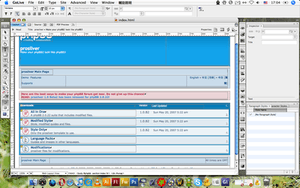Adobe GoLive
Adobe GoLive was a WYSIWYG HTML editor and web site management application from Adobe Systems. It replaced Adobe PageMill as Adobe's primary HTML editor and was itself discontinued in favour of Dreamweaver. The last version of GoLive that Adobe released was GoLive 9.
 Adobe GoLive 9 running under Mac OS X | |
| Developer(s) | Adobe Systems |
|---|---|
| Stable release | 9.0
/ June 1, 2007 |
| Written in | C++ |
| Operating system | Mac OS X and Microsoft Windows |
| Type | HTML editor |
| License | Proprietary |
| Website | www.adobe.com/products/golive/ |
History
GoLive originated as the flagship product of a company named GoNet Communication, Inc. then based in Menlo Park, California,[1] and the development company GoNet Communications GmbH in Hamburg, Germany, in 1996. Later GoNet changed its name to GoLive Systems, Inc, and the name of its product to GoLive CyberStudio. Adobe acquired GoLive in 1999 and re-branded the GoLive CyberStudio product to what became Adobe GoLive. Adobe took over the Hamburg office as an Adobe development site to continue to develop the product.
The first versions of Dreamweaver and Cyberstudio were released in a similar timeframe. However, Dreamweaver eventually became the dominant WYSIWYG HTML editor in market share. After the Adobe acquisition of Macromedia (the company that had owned Dreamweaver), GoLive was progressively re-targeted toward Adobe's traditional design market, and the product became better integrated with Adobe's existing suite of design-oriented software products and less focused on the professional web development market.
The Adobe CS2 Premium suite contained GoLive CS2. With the release of Creative Suite 3, Adobe integrated Dreamweaver as a replacement for GoLive and released GoLive 9 as a standalone product.[2]
In April 2008, Adobe announced that sales and development of GoLive would cease in favor of Dreamweaver.[3]
General description and distinctive aspects
GoLive incorporated a largely modeless workflow that relied heavily on drag-and-drop. Most user interaction was done via a contextual inspector rather than the modal workflow found in Dreamweaver. Among its features were a separate editor for tables that supported nesting, and a two-dimensional panel for applying CSS styles to elements. GoLive supported drag-and-drop of native Adobe Photoshop and Adobe Illustrator files via what the company called "Smart Objects", which then automatically guided the user through saving those files in web-supported formats. Updates to the original Photoshop or Illustrator assets were automatically tracked by GoLive. It also implemented a tool called "Components" which allowed updates to interface elements throughout a site to be updated globally by changing one single file. As a website management tool, GoLive allowed users to transfer and publish content directly from within the application, and allowed individual files to be excluded from uploading.
Features
One of the new features of GoLive version 5 was Dynamic Link, which was a method of creating dynamic, database-driven web content without the need to know a server-side language and with full WYSIWYG support in the GoLive user interface.
GoLive had a powerful set of extensibility API which could be used to add additional functionality to the product. The GoLive SDK provided interfaces which allowed developers to use a combination of XML, JavaScript and C/C++ to create plugins for the product.[4] The extensibility API allowed developers access to custom drawing and event handling using JavaScript, as well as a full JavaScript debugger and command line interpreter. This allowed intermediate-level developers using interpreted JavaScript to create sophisticated user interfaces.
Language and framework structure
Adobe GoLive is coded in the C++ programming language.[5] It uses a custom C++ framework called SCL (Simple Class Library) which was initially built from scratch by the engineers at GoLive Systems Inc. The SCL framework was also used in the short-lived Adobe Atmosphere 3D software.
Release history
| Version | Code Name | Supported Platforms | Release Date |
|---|---|---|---|
| GoLive 1.0 | Classic Mac OS | June 1996 | |
| GoLive 1.1 Pro | Classic Mac OS | August 1996 | |
| GoLive CyberStudio 1 | Classic Mac OS | April 1997 | |
| GoLive CyberStudio 2 | Classic Mac OS | September 1997 | |
| GoLive CyberStudio 3 | Classic Mac OS | April 1998 | |
| Adobe GoLive 4 | Classic Mac OS | January 1999 | |
| Adobe GoLive 4 | Microsoft Windows | May 1999 | |
| Adobe GoLive 5 | The Fifth Element | Classic Mac OS, Microsoft Windows | August 2000 |
| Adobe GoLive 6 | The 6th Day | Classic Mac OS, Mac OS X, Microsoft Windows | February 2002 |
| Adobe GoLive 7 CS | Se7en | Mac OS X, Microsoft Windows | October 2003 |
| Adobe GoLive 8 CS2 | Reloaded | Mac OS X, Microsoft Windows | April 2005 |
| Adobe GoLive 9 | Vicious | Universal Mac OS X, Microsoft Windows | June 2007 |
As the final version, GoLive 9 was discontinued in April 2008.
References
- InfoWorld Jul. 22,1996.
- Adobe PressRoom Archived 2007-03-23 at the Wayback Machine
- Cohen, Peter (27 April 2008). "Adobe discontinues GoLive". Macworld. Archived from the original on 29 April 2008. Retrieved 28 April 2008.
- Adobe GoLive SDK Archived August 4, 2010, at the Wayback Machine
- Bjarne Stroustrup. C++ applications, 25 May 2007. Retrieved on 19 June 2007.
External links
| Wikibooks has a book on the topic of: Adobe GoLive Guide |
- Adobe GoLive homepage
- OReilly Article with GoLive History
- mprove: Adobe GoLive’s Point & Shoot - an interface technique for creating hyperlinks
- Adobe GoLive Tutorials & Resource Site
- GoLive CS2 Tutorials and Reference
- GoLiveCentral - Tutorials & Resources
- Revive GoLive Adobe Forum
- chronicles from the GoLive era